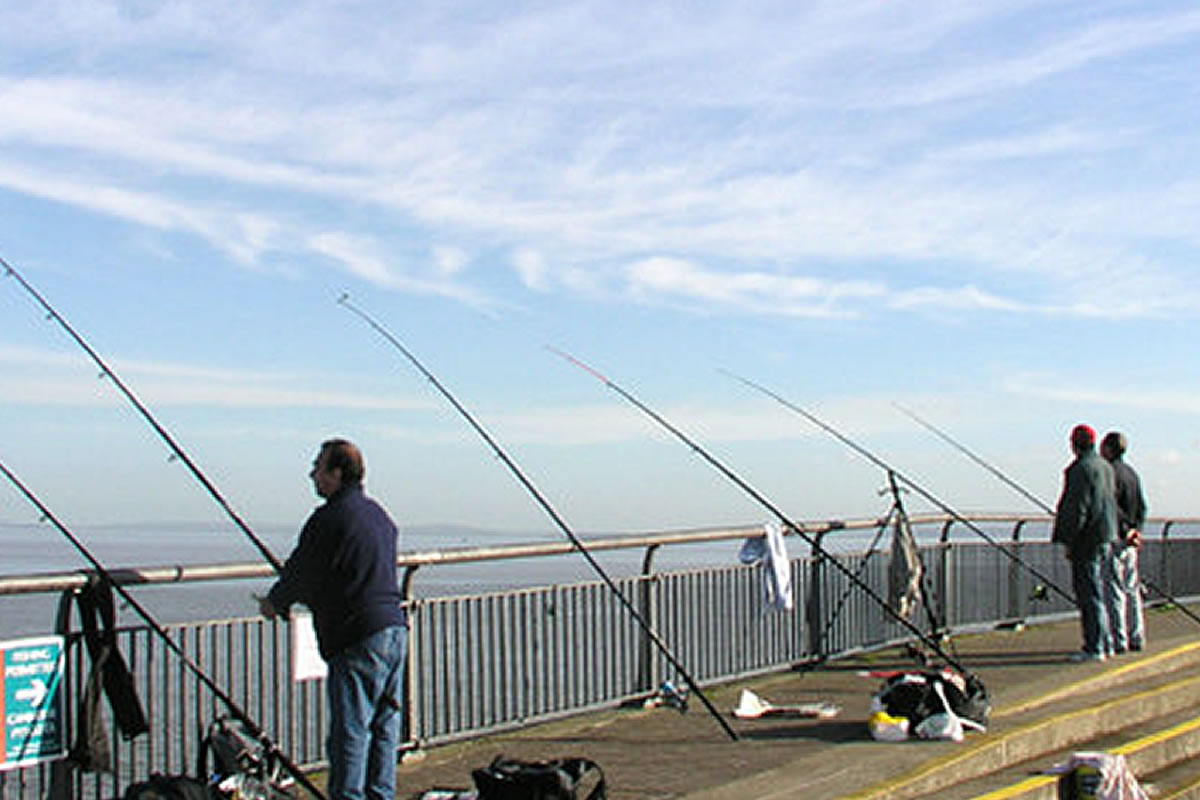
There’s something quietly ritualistic about fishing in winter: the breath that fogs in front of your face, the thin, metallic light over the water, the satisfying click of terminal tackle as you set up. At the Cardiff Barrage, those same elements combine with a unique waterfront backdrop – the hulking sweep of the barrage itself, the low winter sun glancing off calm channels, and the occasional cry of a gull – to make cold-season fishing not just survivable, but oddly addictive. In this post, I want to capture why winter at the Barrage is so special, what people catch, and why its popularity peaks even when the mercury drops.
The winter atmosphere — stripped-back, focused, beautiful
In summer, the barrage and the bay are a whir of activity: families, joggers, cafés and boats. In winter, everything pares back. Fewer people on the promenade means more space for anglers to stake out prime marks. The light is lower and more sculpted; the air holds that damp, metallic clarity that makes long casts seem more precise. There’s a hush to the water that you don’t always get in busy months – which amplifies every small thrill, from the whisper of a line through the guides to the sudden, unmistakable throb of a take.
Cold-weather fishing also sharpens the social feel. Because it’s tougher, the people you see are usually there because they want to be: regulars who know the tides, day-trippers toughing out the elements, and newcomers with the wide-eyed look of someone who’s discovered a rewarding secret. Conversations are brief but meaningfully practical – “What rigs are you running?” and “How’s the ebb?” – and there’s an unspoken camaraderie when someone struggles with frozen bait or celebrates a mid-winter catch.
What’s being caught (and when)
Winter fishing at the Barrage tends to favour a handful of species and tactics. The exact mix varies with tide, time of day and conditions, but anglers commonly report action from estuarine and coastal species that move through the bay in colder months. Expect to see a lot of behaviour like this:
-
Short sessions during the tide change – many anglers time their outings around the run-in or run-out when fish are more actively feeding.
-
Bait and lure options both working well – from simple baits fished on the bottom to light lure tactics for opportunistic predators.
-
Puts and takes – smaller bites that require patience and good rod feel; winter fish are often less aggressive but still willing to take a well-presented offering.
If you’re new to the spot, aim to learn the tide patterns and watch the water. Schools of baitfish, diving birds and the direction of current seams are the kind of visual clues that pay off when temperatures are low and fish are being selective.
Practical winter tips — keep warm, smart, and patient
Fishing the Barrage in winter is as much about preparation as it is about technique. A little planning saves a lot of teeth-chattering.
- Clothing: Layer up. A windproof outer layer, warm mid-layers, and thermal base layers make standing for long periods bearable. Gloves that allow fine finger movement are a must – you’ll thank yourself when setting a hook.
- Footwear: Waterproof, insulated boots with good grip are essential. The promenade and banks can be damp, slimy or icy in spots.
- Tackle: Keep rigs simple and reliable. In cold weather, fish can be wary, so subtle presentations often land more fish than over-complicated tackle. Spare leaders, hooks and a strong landing net are good to have on hand.
- Bait: Natural baits can still do well in winter, but so can small soft plastics or metal lures if you prefer casting. Keep baits fresh and change them often – fish in chilly water have slower metabolisms and can be picky about presentation.
- Timing: Tide changes are king. Many anglers prefer arriving 30–60 minutes before a tide change and staying until the run eases. Low light – dawn and dusk – often concentrates feeding activity, so don’t be afraid of early starts or late finishes.
- Safety: Tell someone where you’re going and when you expect to be back. Winter conditions can change quickly; mobile signal may be patchy in parts. A small first-aid kit, a charged phone and some hot drink in a flask are sensible comfort and safety measures.
Why it stays popular in winter
You might reasonably ask: with the cold and the shorter days, why do so many people still bother? There are a few reasons that keep anglers coming back.
-
Consistency of access. The Barrage’s promenade and access points make it straightforward to get on the water even in poor weather. You don’t need a boat, a long walk, or complex logistics; that ease of access is huge during winter when motivation is the limiting factor for many.
-
Good variety of winter species. The mix of estuary and near-coastal species creates opportunities for anglers who enjoy trying different approaches: pitching baits for bottom-feeders, working small lures for predators, or simply waiting for a surprise grab.
-
Community and competition. Regulars keep each other informed – where the action was that morning, who had a good session on the last tide. That social network is friendly and practical, and it makes cold mornings easier to face. On top of that, there’s a quiet rivalry – land the best winter fish and you’ll earn a few knowing nods.
-
The reward factor. There’s something about catching in difficult conditions that makes a fish feel earned. A winter fish rarely feels routine; it feels like a small victory. That psychological payoff keeps people tying rigs when the forecast looks bleak.
Stories from the bank
One of the best parts of Barrage fishing is the stories you hear: the guy who netted a surprising specimen on a biting January wind, the pair of friends who made a ritual of meeting at first light once a month, the young angler who landed their first proper catch and decided to come back every weekend. These small narratives thread together to form the place’s reputation – a place where commitment is rewarded and where friendships are forged over coffee and tangled lines.
Final cast — a winter invitation
Winter at the Cardiff Barrage isn’t about comfort; it’s about focus. If you’re prepared – dress warm, keep tackle simple, and pay attention to tides and the water – you’ll find the rewards are plenty. The spot’s popularity in the cold months comes from a mix of accessibility, consistent fish presence, and the unique atmosphere that only brisk, clear mornings can deliver. Whether you’re a seasoned regular or someone tempted to finally try a winter dawn session, the barrage has a way of turning early discomfort into an afternoon story worth telling.
So next time the forecast looks grey and the kettle is calling, consider this a gentle nudge: layer up, tie on a leader, and meet the water. The Barrage in winter has patience, and it rewards the patient. Tight lines.




